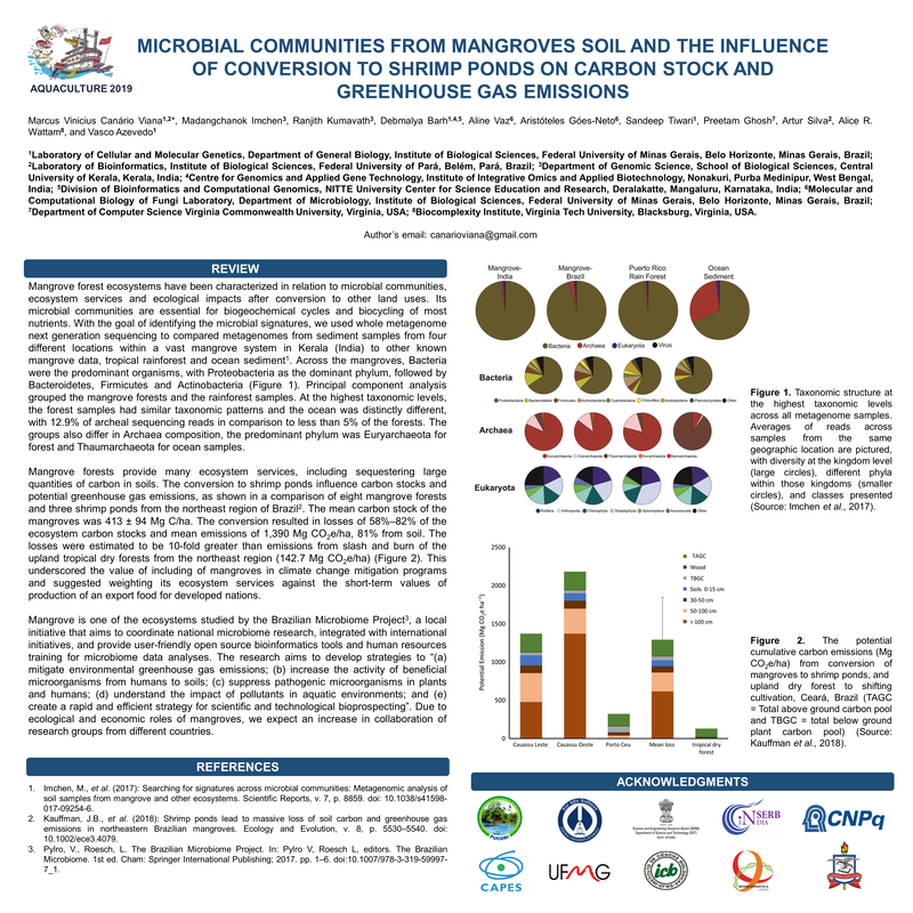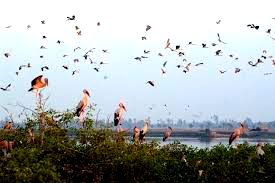SUPUESTOS ERRÓNEOS Y FECHADOS PRODUCEN UNA 'HUELLA DE CARBONO' ENGAÑOSA PARA cuLTIVO DE CAMARONES
By
Global Aquaculture Alliance
Una presentación del ecologista J. Boone Kauffman de la Universidad Estatal de Oregon en la reunión de 2012 de la Asociación Estadounidense para el Avance de la Ciencia ha dado lugar a una serie de artículos sensacionalistas y engañosos sobre los impactos del cultivo de camarón.
Si bien la Global Aquaculture Alliance no discute las preocupaciones de Kauffman sobre la huella de carbono de convertir los manglares para otros usos, GAA desafía sus suposiciones sobre el papel del cultivo de camarón en tales conversiones.
Kauffman alcanzó valores de huella de carbono que no son aplicables a la gran mayoría de la acuicultura de camarón que se practica en la actualidad, dijo el presidente de la Alianza Global de Acuicultura, George Chamberlain. Solo alrededor del 3 por ciento de la producción mundial actual de camarón cultivado se obtiene en las condiciones en las que Kauffman basó sus cálculos.
El documento informativo de Kauffman dijo que del 50 al 60 por ciento de las granjas camaroneras se construyen en antiguas áreas de manglares, tienen una productividad anual de solo 50 a 500 kilogramos por hectárea y se abandonan en solo tres a nueve años. Combinando estas suposiciones erróneas, concluyó que la liberación de dióxido de carbono a través de la conversión de tierra de manglares en estanques de camarones produce una huella de 198 kilogramos por 100 gramos de camarón comestible.
"Es importante comprender qué tan lejos están esos números", dijo Chamberlain.
En una investigación con Jason Clay de World Wildlife Fund, el científico de acuicultura Claude Boyd estimó que menos del 10 por ciento de la pérdida histórica de manglares se debió a la construcción de granjas camaroneras. La práctica de convertir áreas de manglares en estanques de camarones esencialmente se detuvo hace casi dos décadas debido a la fuerte presión regulatoria y de la industria. Las principales causas de la pérdida de manglares son la agricultura, los estanques de evaporación de sal, la minería y el desarrollo de infraestructura.
Aunque es común en la década de 1980, los métodos de cultivo de baja densidad descritos por Kauffman se limitan actualmente a áreas limitadas de Bangladesh, Indonesia y el sur de Vietnam, y ahora representan solo un pequeño porcentaje de la cosecha mundial total de camarón.
Es inexacto suponer que los estanques de camarones tienen una vida útil de tres a nueve años, dijo Dan Lee, coordinador de estándares de mejores prácticas de acuicultura de GAA. Si bien las granjas camaroneras construidas en áreas de manglares son inherentemente inferiores a los estanques de mayor elevación debido a los suelos de sulfato ácido y al drenaje limitado, se vuelven menos problemáticos con el tiempo a medida que el ácido se neutraliza gradualmente. Los estanques de manglares en Ecuador y Honduras todavía están en funcionamiento después de 40 años, y los estanques tradicionales "tambak" han producido peces y camarones en Indonesia durante cientos de años.
"Si bien la Alianza Mundial para la Acuicultura apoya la valoración que hace Kauffman de los manglares como importantes sumideros de carbono ecológico que deben conservarse, discrepamos con sus cálculos sobre el cultivo de camarón", dijo Chamberlain. "Sus suposiciones guardan poca relación con la industria camaronera actual, que hace mucho tiempo que se alejó de la zona de manglares. Es similar a calcular la erosión del suelo para la agricultura de Estados Unidos con base en las prácticas del Dust Bowl de la década de 1930".
Los números de Kauffman fueron distribuidos rápidamente por varias entidades de medios, a menudo en artículos con titulares en contra del camarón. Además, algunos editores desatentos informaron incorrectamente sus datos y afirmaron que solo se produce 1 kilogramo de camarón en 13,4 kilómetros cuadrados de estanque, una estadística absurda.
"" Es muy lamentable que estos mensajes engañosos estén circulando ", dijo Lee," GAA espera sinceramente que cuando los consumidores y otras personas lean ese material, puedan reconocer lo desactualizado y distorsionado que está ".
Fuente:http://www.gaalliance.org/newsroom/news.php?Dated-Erroneous-Assumptions-Yield-Misleading-Carbon-Footprint-For-Farmed-Shrimp-59
Si bien la Global Aquaculture Alliance no discute las preocupaciones de Kauffman sobre la huella de carbono de convertir los manglares para otros usos, GAA desafía sus suposiciones sobre el papel del cultivo de camarón en tales conversiones.
Kauffman alcanzó valores de huella de carbono que no son aplicables a la gran mayoría de la acuicultura de camarón que se practica en la actualidad, dijo el presidente de la Alianza Global de Acuicultura, George Chamberlain. Solo alrededor del 3 por ciento de la producción mundial actual de camarón cultivado se obtiene en las condiciones en las que Kauffman basó sus cálculos.
El documento informativo de Kauffman dijo que del 50 al 60 por ciento de las granjas camaroneras se construyen en antiguas áreas de manglares, tienen una productividad anual de solo 50 a 500 kilogramos por hectárea y se abandonan en solo tres a nueve años. Combinando estas suposiciones erróneas, concluyó que la liberación de dióxido de carbono a través de la conversión de tierra de manglares en estanques de camarones produce una huella de 198 kilogramos por 100 gramos de camarón comestible.
"Es importante comprender qué tan lejos están esos números", dijo Chamberlain.
En una investigación con Jason Clay de World Wildlife Fund, el científico de acuicultura Claude Boyd estimó que menos del 10 por ciento de la pérdida histórica de manglares se debió a la construcción de granjas camaroneras. La práctica de convertir áreas de manglares en estanques de camarones esencialmente se detuvo hace casi dos décadas debido a la fuerte presión regulatoria y de la industria. Las principales causas de la pérdida de manglares son la agricultura, los estanques de evaporación de sal, la minería y el desarrollo de infraestructura.
Aunque es común en la década de 1980, los métodos de cultivo de baja densidad descritos por Kauffman se limitan actualmente a áreas limitadas de Bangladesh, Indonesia y el sur de Vietnam, y ahora representan solo un pequeño porcentaje de la cosecha mundial total de camarón.
Es inexacto suponer que los estanques de camarones tienen una vida útil de tres a nueve años, dijo Dan Lee, coordinador de estándares de mejores prácticas de acuicultura de GAA. Si bien las granjas camaroneras construidas en áreas de manglares son inherentemente inferiores a los estanques de mayor elevación debido a los suelos de sulfato ácido y al drenaje limitado, se vuelven menos problemáticos con el tiempo a medida que el ácido se neutraliza gradualmente. Los estanques de manglares en Ecuador y Honduras todavía están en funcionamiento después de 40 años, y los estanques tradicionales "tambak" han producido peces y camarones en Indonesia durante cientos de años.
"Si bien la Alianza Mundial para la Acuicultura apoya la valoración que hace Kauffman de los manglares como importantes sumideros de carbono ecológico que deben conservarse, discrepamos con sus cálculos sobre el cultivo de camarón", dijo Chamberlain. "Sus suposiciones guardan poca relación con la industria camaronera actual, que hace mucho tiempo que se alejó de la zona de manglares. Es similar a calcular la erosión del suelo para la agricultura de Estados Unidos con base en las prácticas del Dust Bowl de la década de 1930".
Los números de Kauffman fueron distribuidos rápidamente por varias entidades de medios, a menudo en artículos con titulares en contra del camarón. Además, algunos editores desatentos informaron incorrectamente sus datos y afirmaron que solo se produce 1 kilogramo de camarón en 13,4 kilómetros cuadrados de estanque, una estadística absurda.
"" Es muy lamentable que estos mensajes engañosos estén circulando ", dijo Lee," GAA espera sinceramente que cuando los consumidores y otras personas lean ese material, puedan reconocer lo desactualizado y distorsionado que está ".
Fuente:http://www.gaalliance.org/newsroom/news.php?Dated-Erroneous-Assumptions-Yield-Misleading-Carbon-Footprint-For-Farmed-Shrimp-59
Clarificar el papel de los sistemas costeros y marinos en la mitigación del clima
Manglares y CO2
La comunidad científica internacional reconoce cada vez más el papel de los sistemas naturales en la mitigación del cambio climático. Si bien los bosques han sido históricamente el foco principal de tales esfuerzos, los humedales costeros, en particular pastos marinos, marismas y manglares, ahora se consideran importantes y efectivos sumideros de carbono a largo plazo. Sin embargo, algunos miembros de la comunidad de gestión y políticas costeras y marinas han estado interesados en ampliar las estrategias de mitigación del clima para incluir otros componentes dentro de los sistemas costeros y marinos, como los arrecifes de coral, el fitoplancton, los bosques de algas marinas y la fauna marina. Analizamos la evidencia científica sobre si estos ecosistemas marinos y componentes del ecosistema son sumideros de carbono viables a largo plazo y si se pueden gestionar para la mitigación del clima. Nuestros hallazgos podrían ayudar a los tomadores de decisiones y a los profesionales de la conservación a identificar qué componentes de los ecosistemas costeros y marinos deben priorizarse en las estrategias y políticas actuales de mitigación del clima.
Lee más al respecto en: http://onlinelibrary.wiley.com/doi/10.1002/fee.1451/full
ESTIMACIÓN DE LAS EMISIONES GLOBALES DE "CARBONO AZUL" DE LA CONVERSIÓN Y DEGRADACIÓN DE ECOSISTEMAS COSTERoS VEGETADOS
Linwood Pendleton 1. , Daniel C. Donato 2*., Brian C. Murray1, Stephen Crooks3, W. Aaron Jenkins1,Samantha Sifleet4, Christopher Craft5, James W. Fourqurean6, J. Boone Kauffman7, Nu´ ria Marba`8,Patrick Megonigal9, Emily Pidgeon10, Dorothee Herr11, David Gordon1, Alexis Baldera12.
La atención reciente se ha centrado en las altas tasas de secuestro de carbono anual en los ecosistemas costeros con vegetación (marismas, manglares y pastos marinos) que pueden perderse con la destrucción del hábitat ("conversión"). Sin embargo, relativamente poco apreciado es que la conversión de estos ecosistemas costeros también impacta grandes reservas de carbono previamente secuestrado. Residiendo principalmente en sedimentos, este "carbono azul" puede liberarse a la atmósfera cuando estos ecosistemas se convierten o degradan. Aquí proporcionamos las primeras estimaciones globales de este impacto y evaluamos sus implicaciones económicas. Combinando los mejores datos disponibles sobre el área global, las tasas de conversión del uso de la tierra y las reservas de carbono cerca de la superficie en cada uno de los tres ecosistemas, utilizando un enfoque de propagación de la incertidumbre, estimamos que entre 0,15 y 1,02 Pg (mil millones de toneladas) de dióxido de carbono siendo liberado anualmente, varias veces más alto que las estimaciones anteriores que solo dan cuenta de la pérdida de secuestro. Estas emisiones son equivalentes al 3–19% de las de la deforestación a nivel mundial y dan como resultado daños económicos de $ US 6–42 mil millones al año. Las mayores fuentes de incertidumbre en estas estimaciones provienen de la certeza limitada en el área global y las tasas de conversión del uso de la tierra, pero también se necesita investigación sobre el destino del carbono del ecosistema después de la conversión. Actualmente, las emisiones de carbono de la conversión de ecosistemas costeros con vegetación no están incluidas en los protocolos de contabilidad de emisiones o mercado de carbono, pero este análisis sugiere que pueden ser desproporcionadamente importantes para ambos. Aunque la ciencia relevante que respalda estas estimaciones iniciales deberá perfeccionarse en los próximos años, está claro que las políticas que fomentan la gestión sostenible de los ecosistemas costeros podrían reducir significativamente las emisiones de carbono del sector del uso de la tierra, además de mantener los servicios ecosistémicos bien reconocidos de hábitats costeros.
1 Nicholas Institute for Environmental Policy Solutions, Duke University, Durham, North Carolina, United States of America, 2 Ecosystem & Landscape Ecology Lab, University of Wisconsin, Madison, Wisconsin, United States of America, 3 ESA Phillip Williams & Associates, San Francisco, California, United States of America, 4 United States Environmental Protection Agency, Research Triangle Park, North Carolina, United States of America, 5 School of Public and Environmental Affairs, Indiana University, Bloomington, Indiana, United States of America, 6Department of Biological Sciences and Southeast Environmental Research Center, Florida International University, North Miami, Florida, United States of America, 7 Department of Fisheries and Wildlife, Oregon State University, Corvallis, Oregon, United States of America and Center for International Forest Research, Bogor, Indonesia, 8 Department of Global Change Research, Mediterranean Institute for Advanced Studies, Esporles, Illes Balears, Spain, 9 Smithsonian Environmental Research Center, Edgewater, Maryland, United States of America, 10 Conservation International, Arlington, Virginia, United States of America, 11 International Union for the Conservation of Nature, Washington, District of Columbia, United States of America, 12 The Ocean Conservancy, Baton Rouge, Louisiana, United States of America
Fuente: http://www.ncbi.nlm.nih.gov/pmc/articles/PMC3433453/pdf/pone.0043542.pdf
La atención reciente se ha centrado en las altas tasas de secuestro de carbono anual en los ecosistemas costeros con vegetación (marismas, manglares y pastos marinos) que pueden perderse con la destrucción del hábitat ("conversión"). Sin embargo, relativamente poco apreciado es que la conversión de estos ecosistemas costeros también impacta grandes reservas de carbono previamente secuestrado. Residiendo principalmente en sedimentos, este "carbono azul" puede liberarse a la atmósfera cuando estos ecosistemas se convierten o degradan. Aquí proporcionamos las primeras estimaciones globales de este impacto y evaluamos sus implicaciones económicas. Combinando los mejores datos disponibles sobre el área global, las tasas de conversión del uso de la tierra y las reservas de carbono cerca de la superficie en cada uno de los tres ecosistemas, utilizando un enfoque de propagación de la incertidumbre, estimamos que entre 0,15 y 1,02 Pg (mil millones de toneladas) de dióxido de carbono siendo liberado anualmente, varias veces más alto que las estimaciones anteriores que solo dan cuenta de la pérdida de secuestro. Estas emisiones son equivalentes al 3–19% de las de la deforestación a nivel mundial y dan como resultado daños económicos de $ US 6–42 mil millones al año. Las mayores fuentes de incertidumbre en estas estimaciones provienen de la certeza limitada en el área global y las tasas de conversión del uso de la tierra, pero también se necesita investigación sobre el destino del carbono del ecosistema después de la conversión. Actualmente, las emisiones de carbono de la conversión de ecosistemas costeros con vegetación no están incluidas en los protocolos de contabilidad de emisiones o mercado de carbono, pero este análisis sugiere que pueden ser desproporcionadamente importantes para ambos. Aunque la ciencia relevante que respalda estas estimaciones iniciales deberá perfeccionarse en los próximos años, está claro que las políticas que fomentan la gestión sostenible de los ecosistemas costeros podrían reducir significativamente las emisiones de carbono del sector del uso de la tierra, además de mantener los servicios ecosistémicos bien reconocidos de hábitats costeros.
1 Nicholas Institute for Environmental Policy Solutions, Duke University, Durham, North Carolina, United States of America, 2 Ecosystem & Landscape Ecology Lab, University of Wisconsin, Madison, Wisconsin, United States of America, 3 ESA Phillip Williams & Associates, San Francisco, California, United States of America, 4 United States Environmental Protection Agency, Research Triangle Park, North Carolina, United States of America, 5 School of Public and Environmental Affairs, Indiana University, Bloomington, Indiana, United States of America, 6Department of Biological Sciences and Southeast Environmental Research Center, Florida International University, North Miami, Florida, United States of America, 7 Department of Fisheries and Wildlife, Oregon State University, Corvallis, Oregon, United States of America and Center for International Forest Research, Bogor, Indonesia, 8 Department of Global Change Research, Mediterranean Institute for Advanced Studies, Esporles, Illes Balears, Spain, 9 Smithsonian Environmental Research Center, Edgewater, Maryland, United States of America, 10 Conservation International, Arlington, Virginia, United States of America, 11 International Union for the Conservation of Nature, Washington, District of Columbia, United States of America, 12 The Ocean Conservancy, Baton Rouge, Louisiana, United States of America
Fuente: http://www.ncbi.nlm.nih.gov/pmc/articles/PMC3433453/pdf/pone.0043542.pdf




